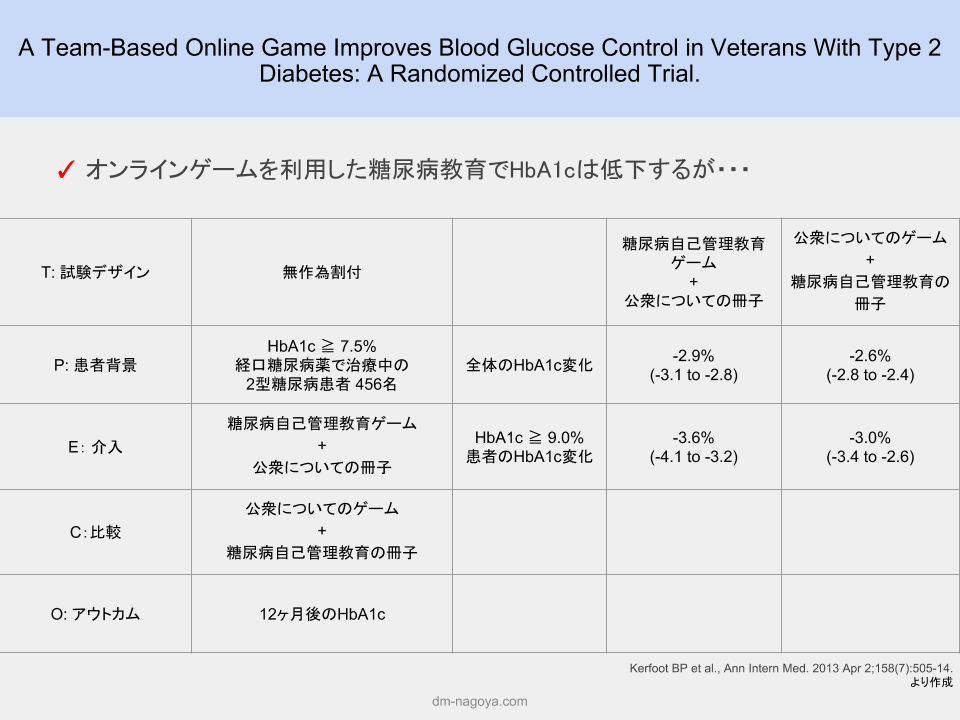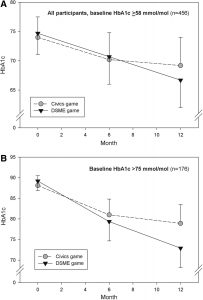■ 試験デザイン
TPECOに分けると下記のようになります
T: 試験デザイン無作為割付
P: 患者背景
HbA1c ≧ 7.5%
経口糖尿病薬で治療中の
2型糖尿病患者 456名
E: 介入
糖尿病自己管理教育ゲーム + 公衆についての冊子
C:比較
公衆についてのゲーム + 糖尿病自己管理教育の冊子
O: アウトカム
12ヶ月後のHbA1c
* HbA1cがIFCC mmol/molなので、HbA1c(NGSP)%に変換して紹介しています。
単位変換はこちらのサイトを参考にしてください。
■ 結果
DSME game patients had significantly greater HbA1c reductions over 12 months than civics game patients (-8 mmol/mol [95% CI -10 to -7] and -5 mmol/mol [95% CI -7 to -3], respectively; P = 0.048). HbA1c reductions were greater among patients with baseline HbA1c >75 mmol/mol: -16 mmol/mol [95% CI -21 to -12] and -9 mmol/mol [95% CI -14 to -5] for DSME and civics game patients, respectively; P = 0.031.
介入群だけでなく、対象群のHbA1c改善効果がすごいので、気になって本文を調べてみると以下の記載がありました。
PPR was generated for oral diabetes medications during the intervention and follow-up periods and was calculated by taking the total number of day’s supply that the patient received over the course of the study, including any fills that overlapped the beginning or end of the study period, divided by the time between the first fill date and the fill date of the first prescription outside of the study period. If the patient was on multiple diabetes drugs, PPRs were averaged across drugs taken in the same study period. Charlson comorbidity indices, Elixhauser comorbidity indices, and Diabetes Complications Severity Scale scores were calculated using ICD-9 coding algorithms (25–27).
注 PPR=pill possession ratio 薬の内服実施率
治療の変更についての詳細は見当たりませんでしたが、上記のように記載があり介入前の服薬実施率に合わせていたようです。そして次の2つが面白いです
Clinical Data Sources
At enrollment and at 6 and 12 months after the launch of the game, patients were sent a home test kit and asked to return a fingerstick blood sample blotted on filter paper and urine specimen by mail. These specimens were assayed by a commercial laboratory for HbA1c (coefficient of variation: 3.0–3.9%), urine albumin, and urine creatinine (Home Access Inc.). Patient information was withheld from the outside laboratory through use of coded identifiers. In addition, patients completed two online questionnaires: an 8-item Diabetes Empowerment Scale (DES) Short Form (23) and 20-item Problem Areas in Diabetes (PAID) questionnaire (24), at baseline, 6 months, and 12 months. Patients were sent a $75 gift certificate at each of these time points. Additional clinical data were extracted from the VA Corporate Data Warehouse.
Although rewards were structured to take advantage of the demonstrated efficacy of group-based financial incentives (21), we also included individual-based awards to maintain engagement among participants on lower-performing teams. At the end of the game, all members of the two teams with the most points in each arm received a $100 gift certificate to an online store. In addition, the top 30% of individual patients on the remaining teams in each arm received a $100 gift certificate.
研究終了で$75
2試合それぞれの勝利チームには$100
2試合それぞれの負けたチームの上位30%にも$100
最大$275、最低$75というインセンティブがあったようです。
これをみるとオンラインゲームの影響よりも金銭インセンティブの影響のほうが大きい気がしてしまいますね。金銭インセンティブによる糖尿病改善効果について少し調べてみたいところです。$275でHbA1cが2~3%下がるなら薬よりもずっと安いし良さそうですね。
■ 参照文献
Kerfoot BP et al., Diabetes Care. 2017 Sep;40(9):1218-1225.
PMID: 28790131

